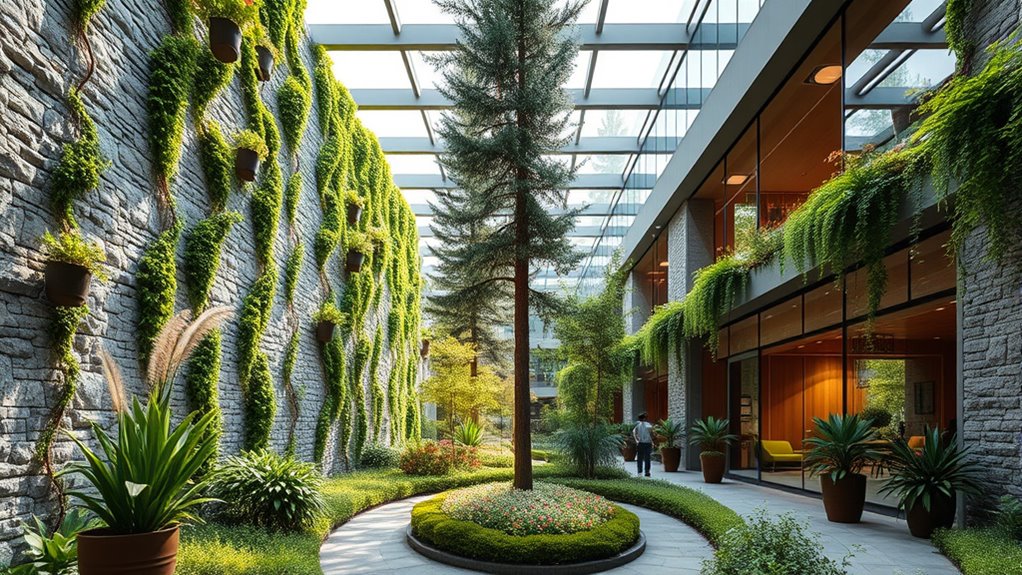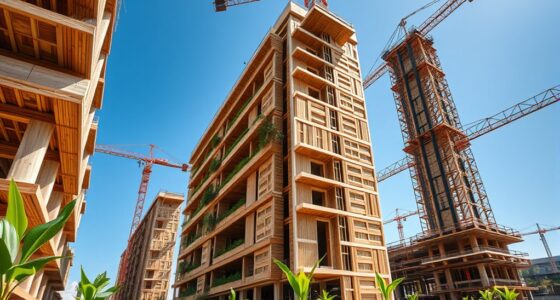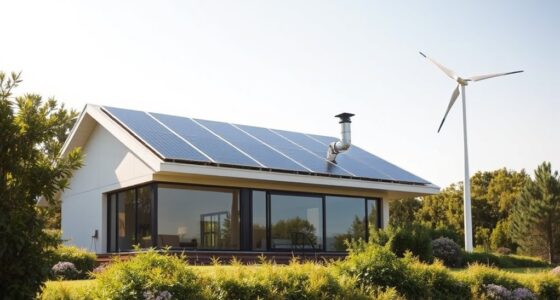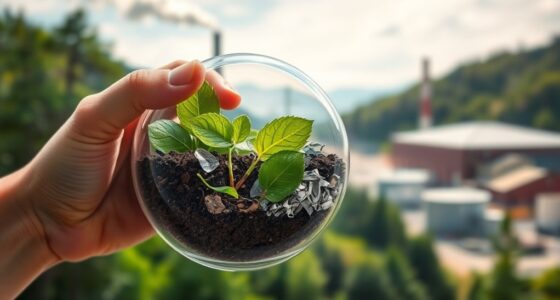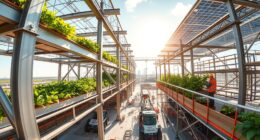Biophilic design helps you connect with nature by seamlessly blending natural elements like greenery and sunlight into your built environment. You can experience the calming benefits of indoor plants and enjoy the uplifting effects of natural light, which boost mood, focus, and overall well-being. By incorporating these features, your space becomes more inviting and healthy. Keep exploring how integrating nature into buildings can transform your environment and enhance your daily life.
Key Takeaways
- Biophilic design integrates natural elements like greenery and sunlight into building environments to foster a connection with nature.
- Incorporating indoor plants and natural light enhances mental well-being, reduces stress, and boosts productivity.
- Combining natural light and greenery creates inviting, calming spaces that promote health and happiness.
- This design approach aligns architecture with natural systems to improve environmental quality and occupant comfort.
- Biophilic design supports the human need to reconnect with nature within built environments for overall well-being.

Have you ever wondered how bringing nature into built environments can boost your well-being? It’s a question that lies at the heart of biophilic design, a concept that emphasizes the connection between humans and the natural world. When you incorporate elements like indoor greenery and maximize natural light, you create spaces that feel more alive, calming, and inspiring. These features aren’t just aesthetic choices; they have tangible effects on your mental and physical health, productivity, and overall happiness.
Indoor greenery plays a crucial role in this design approach. By integrating potted plants, living walls, or even small indoor gardens, you bring a slice of nature directly into your daily environment. Plants help purify the air, reduce stress, and boost your mood. They serve as visual anchors that remind you of the outdoors, providing a soothing presence amid busy, often sterile interiors. The act of caring for plants can also foster a sense of responsibility and purpose, further enhancing your emotional well-being. Incorporating black coat varieties like the black Golden Retriever can add a striking visual element to your space, emphasizing the connection with nature through living creatures. Additionally, selecting healthy, vibrant plants can further improve the air quality in your environment and contribute to a healthier indoor climate.
Indoor plants improve air quality, reduce stress, and boost mood—bringing nature’s calm directly into your daily life.
Natural light, on the other hand, is a fundamental element of biophilic design. When your space is filled with sunlight, it supports your circadian rhythms, helping regulate sleep and wake cycles. Exposure to natural light has been linked to improved mood and alertness, making your environment feel more vibrant and welcoming. Designing spaces with large windows, skylights, or glass walls isn’t just about aesthetics; it’s about creating a healthier, more energizing atmosphere. When you allow sunlight to flood your space, you reduce reliance on artificial lighting, which can often feel harsh or uninspiring. Moreover, natural lighting can also enhance the visual appeal of your indoor plants and other natural elements. This synergy supports both your physical health and your mental clarity.
Combining indoor greenery with abundant natural light creates a synergy that makes your environment more inviting and healthier. Imagine walking into a room with lush plants bathed in warm sunlight—your space transforms into a sanctuary of calm and vitality. This connection to nature can lower stress levels and increase your focus, whether you’re working, relaxing, or socializing. It also encourages you to spend more time in your environment, fostering a sense of comfort and belonging. Furthermore, integrating these elements aligns with the principles of biophilic design, which has been shown to improve overall well-being and productivity.
Ultimately, biophilic design isn’t just about decorating; it’s about fundamentally improving how you experience your surroundings. When you intentionally incorporate indoor greenery and optimize natural light, you’re not only beautifying your space but also nurturing your well-being. It’s a simple yet powerful way to reconnect with nature, making your environment a place that supports your health, happiness, and productivity every day.
Frequently Asked Questions
How Does Biophilic Design Impact Mental Health?
You might notice that your mental health improves when you’re surrounded by nature or natural elements. Biophilic design boosts stress reduction and offers cognitive benefits by creating calming, engaging environments. It encourages natural light, greenery, and organic forms, helping you feel more relaxed and focused. When spaces connect with nature, you’re likely to experience less anxiety and better mental clarity, making your environment a supportive part of your well-being.
What Are Cost Considerations for Implementing Biophilic Elements?
When considering implementing biophilic elements, you should weigh initial installation costs against long-term maintenance. While installing natural features like green walls or indoor gardens can be expensive upfront, they often reduce energy costs and improve well-being over time. You’ll need to plan for ongoing upkeep, but the benefits to your space’s aesthetics and health can outweigh these expenses, making it a worthwhile investment for your environment.
Can Biophilic Design Improve Workplace Productivity?
Like Pandora opening her box, embracing biophilic design can unleash workplace innovation and boost employee satisfaction. When you incorporate natural elements, you create a calming environment that reduces stress and enhances focus. This connection to nature fosters creativity and collaboration, leading to increased productivity. By integrating biophilic design, you not only improve workspaces but also inspire your team to perform at their best, transforming the ordinary into extraordinary.
Are There Specific Plants Recommended for Indoor Biophilic Spaces?
When choosing indoor plants for biophilic spaces, focus on indoor plant selection and biophilic plant types that thrive indoors. Popular options include snake plants, pothos, and peace lilies, which are easy to care for and improve air quality. These plants add natural beauty and calmness to your environment, enhancing well-being. Select plants based on light, humidity, and maintenance needs to create a healthy, inviting space that connects you with nature.
How Does Biophilic Design Influence Energy Efficiency?
Imagine sunlight streaming through windows, warming your space naturally, while lush greenery cools the air. This visual contrast highlights how biophilic design boosts energy savings through thermal regulation, reducing reliance on artificial heating and cooling. By integrating natural elements, you optimize insulation and airflow, ultimately lowering energy costs. Embracing this approach creates a comfortable environment that’s both eco-friendly and cost-effective, making your building more sustainable and inviting.
Conclusion
By embracing biophilic design, you bring the outdoors inside, creating spaces that boost well-being and productivity. It’s a win-win situation that proves nature and architecture can go hand in hand. When you incorporate natural elements, you’re not just building structures—you’re building harmony with the environment. Remember, a stitch in time saves nine; investing in nature-inspired design now guarantees a healthier, happier future for everyone who uses the space.
